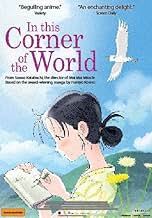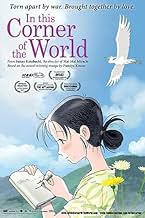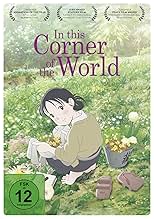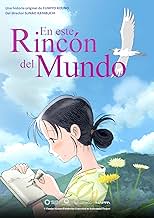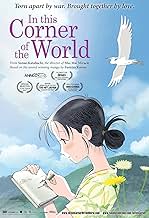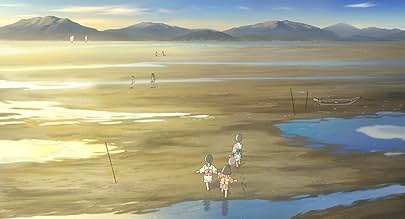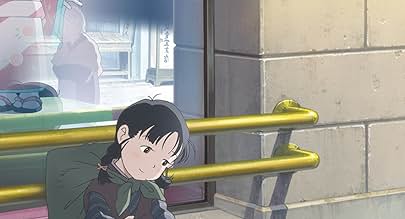IMDb RATING
7.8/10
13K
YOUR RATING
A spirited 18-year-old woman is married off to a man she barely knows as she combats the daily struggles of living in Hiroshima during World War II.A spirited 18-year-old woman is married off to a man she barely knows as she combats the daily struggles of living in Hiroshima during World War II.A spirited 18-year-old woman is married off to a man she barely knows as she combats the daily struggles of living in Hiroshima during World War II.
- Director
- Writers
- Stars
- Awards
- 10 wins & 11 nominations total
Ava Pickard
- Suzu (Young)
- (English version)
- (voice)
Kenna Pickard
- Harumi
- (English version)
- (voice)
Karen Strassman
- Rin
- (English version)
- (voice)
Melodee Spevack
- Kiseno
- (English version)
- (voice)
Michael Sorich
- Juro
- (English version)
- (voice)
Tony Azzolino
- Yoichi
- (English version)
- (voice)
Anne Yatco
- Additional Voices
- (English version)
- (voice)
Bailey Bucher
- Additional Voices
- (English version)
- (voice)
Bryce Papenbrook
- Additional Voices
- (English version)
- (voice)
Cherami Leigh
- Additional Voices
- (English version)
- (voice)
Christopher Corey Smith
- Additional Voices
- (English version)
- (voice)
- (as Christopher Smith)
Cindy Robinson
- Additional Voices
- (English version)
- (voice)
Cristina Valenzuela
- Additional Voices
- (English version)
- (voice)
Dane Price
- Additional Voices
- (English version)
- (voice)
Dorothy Elias-Fahn
- Additional Voices
- (English version)
- (voice)
- (as Johanna Luis)
Joe Ochman
- Additional Voices
- (English version)
- (voice)
- (as Joseph Whimms)
Julie Ann Taylor
- Additional Voices
- (English version)
- (voice)
- Director
- Writers
- All cast & crew
- Production, box office & more at IMDbPro
Featured reviews
This is by no means the first animated film from Japan about life in that country during the Second World War. Isao Takahata's Grave of the Fireflies came out in 1988, and while there are similarities, there are also many differences.
The lead character is called Suzu and we follow her life in and around Kure and Hiroshima before, during and after Japan's involvement in the Second World War. While there is no mention of the attack on Pearl Harbour, America's attacks on mainland Japan are shown in graphic detail. The hardship and suffering of the civilian population is the main focus of the film and punches are definitely not pulled.
All in all a great animated film, personally I'm going to try to watch more films directed by Sunao Katabuchi.
The lead character is called Suzu and we follow her life in and around Kure and Hiroshima before, during and after Japan's involvement in the Second World War. While there is no mention of the attack on Pearl Harbour, America's attacks on mainland Japan are shown in graphic detail. The hardship and suffering of the civilian population is the main focus of the film and punches are definitely not pulled.
All in all a great animated film, personally I'm going to try to watch more films directed by Sunao Katabuchi.
There have been few anime movies which have not left me deeply moved, and this is no exception. Mixing cute anime characters and their straightforward lives (at least on the surface) with the chaos and trauma of the Second World War may seem like an oversimplification of the war and a cheap, melodramatic effort at invoking sadness and tears, but there is a depth to the characters and emotions in this movie, and the ultimate message of the movie is not just that war is devastating and destroys the lives of countless innocents, but also that life moves on in spite of all the carnage, and people change and discover new qualities and things about themselves, transforming them into different (perhaps better?) versions of themselves.
The movie follows our female protagonist Suzu through her childhood to early marriage to the tumultuous years of the War. Suzu is a lovable and cheerful protagonist, gentle and kind but also clumsy and forgetful, redeemed by her artistic talent and her perseverance, but there are hidden depths to her that are only partially revealed through some odd sequences in the first part of the movie, and come into the spotlight in the second part after her traumatic brush with the War. The animation is beautiful, and the attention to detail is superb, transporting the viewer effortlessly to rural Japan in the 1940s. The cultural quirks of this place and era are delightfully presented in the first half of the movie, during which it feels like a gentle slice-of-life movie. Once the War begins in earnest, we see the effect that it has on the ordinary citizens. While there are some traumatic sequences, the movie does not linger on them, and instead it focuses on how the characters handle the changes and come to terms with them, often questioning the futility of all the devastation (especially after Japan loses the War) but also forging new bonds among each other and finding hidden depths in themselves.
One stark criticism of the movie is that some important supporting characters are not properly introduced, and Suzu's own feelings and desires are not properly explored, so that some revelations later on feel artificial and we never really entirely understand Suzu's actions and her motivations. Apparently, an extended version of the movie is being prepared which I feel is definitely required to understand this story in its full details.
The movie follows our female protagonist Suzu through her childhood to early marriage to the tumultuous years of the War. Suzu is a lovable and cheerful protagonist, gentle and kind but also clumsy and forgetful, redeemed by her artistic talent and her perseverance, but there are hidden depths to her that are only partially revealed through some odd sequences in the first part of the movie, and come into the spotlight in the second part after her traumatic brush with the War. The animation is beautiful, and the attention to detail is superb, transporting the viewer effortlessly to rural Japan in the 1940s. The cultural quirks of this place and era are delightfully presented in the first half of the movie, during which it feels like a gentle slice-of-life movie. Once the War begins in earnest, we see the effect that it has on the ordinary citizens. While there are some traumatic sequences, the movie does not linger on them, and instead it focuses on how the characters handle the changes and come to terms with them, often questioning the futility of all the devastation (especially after Japan loses the War) but also forging new bonds among each other and finding hidden depths in themselves.
One stark criticism of the movie is that some important supporting characters are not properly introduced, and Suzu's own feelings and desires are not properly explored, so that some revelations later on feel artificial and we never really entirely understand Suzu's actions and her motivations. Apparently, an extended version of the movie is being prepared which I feel is definitely required to understand this story in its full details.
If you have chance to watch this movie, no matter what you must. And if you like it, you had better go looking ofor original manga book. I have been huge fan of original manga work but am still surprised the quality of this animation version. It was so true to original and yet what added has all tasty meanings. I found this masterpiece of animation as a rare case of triumph being transitioning media.
10Tweekums
This film, centred on Suzu Urano, opens when she is a child in pre-war Japan. She lives in a small town that is part of the city of Hiroshima. She helps her parents farming seaweed and in her free time engages in her love of art. Then, when she is eighteen in 1943, she receives a marriage proposal from a man in the city of Kure; a naval port fifteen miles away. She accepts to proposal and moves to Kure where she becomes part of his family. At first they are unaffected by the war but gradually shortages increase and then the city is targeted by American bombers leading to wide scale destruction and personal tragedy.
Sitting down to watch this I expected that it would be a tear-jerker at times; and it certainly is. What I didn't expect was the sheer joy of most of the first half of the film; pre-war Japan looked idyllic and even in during the war, while the war is far away, it is little changed apart from the shortages and the large number of naval vessels in Kore Bay. There are charming scenes as Suzu gets to know her new home; particularly the scenes where she talks to her new young niece Harumi. The animation is delightful; its water-colour style mirroring Suzu's artwork. Inevitably there will be comparisons with 'Grave of the Fireflies' as both are set in wartime Japan the films feel quite different; while this certainly has its tragic moments the ending isn't so clearly signposted. Overall I'd definitely recommend this thoughtful film; just expect to shed a few tears.
Sitting down to watch this I expected that it would be a tear-jerker at times; and it certainly is. What I didn't expect was the sheer joy of most of the first half of the film; pre-war Japan looked idyllic and even in during the war, while the war is far away, it is little changed apart from the shortages and the large number of naval vessels in Kore Bay. There are charming scenes as Suzu gets to know her new home; particularly the scenes where she talks to her new young niece Harumi. The animation is delightful; its water-colour style mirroring Suzu's artwork. Inevitably there will be comparisons with 'Grave of the Fireflies' as both are set in wartime Japan the films feel quite different; while this certainly has its tragic moments the ending isn't so clearly signposted. Overall I'd definitely recommend this thoughtful film; just expect to shed a few tears.
Greetings again from the darkness. There is something hypnotic about the hand-drawn animation of writer/director Sunao Katabuchi's film based on the 2007-09 Japanese manga (comic) by Fumiyo Kouno. With some similarities to Takahata's 1988 classic Grave of the Fireflies, it's more than a wartime drama – it's a story of the human spirit.
It's 1935 and Suzu is a young girl who lives in Eba, a town in Hiroshima. She is an exceptional artist with a vibrant imagination and an adventurous approach to life. Her innocence and pleasant childhood existence is rocked when, as a teenager, she receives an out-of-the-blue marriage proposal from a stranger. Life with his family in Kure forces Suzu into a daily routine of cleaning, mending and cooking – all while longing for her family in Eba.
The film clicks through the months and years, and provides a history of war time from the perspective of a family and village. While the date of August 6, 1945 hovers on the viewer's mind, we experience how family dynamics are affected by war time. For Suzu, her daily routines such as food preparation provide a necessary structure and distraction, despite the ever-worsening shortage of food and supplies. These stresses are compounded by air raid warnings over the radio and Suzu suffers through vivid nightmares.
We so easily connect with Suzu as she continually fights through hardships – both physical and emotional – because of her determination to live a good life and overcome all obstacles. This is such expert story telling with a beautiful presentation, that the film periodically reminds us that war is close by. Even in a war torn country, the people must find a way to go about daily life while treasuring the rare moments of joy and understanding the strength of togetherness. It's rare that an animated movie can deliver such a humanist look at fully formed characters and their feelings all within a historical setting.
It's 1935 and Suzu is a young girl who lives in Eba, a town in Hiroshima. She is an exceptional artist with a vibrant imagination and an adventurous approach to life. Her innocence and pleasant childhood existence is rocked when, as a teenager, she receives an out-of-the-blue marriage proposal from a stranger. Life with his family in Kure forces Suzu into a daily routine of cleaning, mending and cooking – all while longing for her family in Eba.
The film clicks through the months and years, and provides a history of war time from the perspective of a family and village. While the date of August 6, 1945 hovers on the viewer's mind, we experience how family dynamics are affected by war time. For Suzu, her daily routines such as food preparation provide a necessary structure and distraction, despite the ever-worsening shortage of food and supplies. These stresses are compounded by air raid warnings over the radio and Suzu suffers through vivid nightmares.
We so easily connect with Suzu as she continually fights through hardships – both physical and emotional – because of her determination to live a good life and overcome all obstacles. This is such expert story telling with a beautiful presentation, that the film periodically reminds us that war is close by. Even in a war torn country, the people must find a way to go about daily life while treasuring the rare moments of joy and understanding the strength of togetherness. It's rare that an animated movie can deliver such a humanist look at fully formed characters and their feelings all within a historical setting.
Did you know
- TriviaWith a runtime of 168 minutes, the extended version is the longest animated film ever produced.
- Alternate versionsA rumoured extended version, supposedly titled "Kono Sekai no (Sara ni Ikutsumono) Katsumi ni" ("In This Corner (and Other Corners) of the World"), has supposedly ~30 minutes of additional footage, that is reported to emphasize the relationship between Rin, Shusaku and Suzu. Slated to premiere in mid-December 2019.
- ConnectionsFeatured in In This Corner: Then and Now (2017)
- Soundtrackskanashikite yarikirena
by Kotringo
- How long is In This Corner of the World?Powered by Alexa
Details
Box office
- Gross US & Canada
- $172,147
- Opening weekend US & Canada
- $24,205
- Aug 13, 2017
- Gross worldwide
- $19,496,308
- Runtime2 hours 9 minutes
- Color
- Sound mix
- Aspect ratio
- 1.85 : 1
Contribute to this page
Suggest an edit or add missing content







